Shake up a snow globe and be mesmerised by the sight.
- A snow globe is a decorative novelty item consisting of a scene inside a transparent globular or ellipsoid-like shape.
- ‘Snow globes’ are also known as ‘snow domes’, ‘snow shakers’, ‘snowstorms’, ‘snow scenes’, and ‘water globes’.
- Snow globes generally consist of tiny white flakes in a liquid, which is mainly water, which when shaken up, simulates snow falling.
- It is thought that snow globes originated in France in Europe, with the first known record being a globe of water and white powder, with a man holding an umbrella, which was on display at the Paris Universal Expo in 1878.
- To prevent the liquid inside a snow globe from freezing during cold temperatures, an antifreeze such as glycol, is often added to the water, while glycerine or another ingredient is sometimes added to slow the movement of the flakes in the liquid.
Snow Globe
Image courtesy of Nick Harris/Flickr
- Snow globes were first patented in the year 1900, in Austria, by Erwin Perzy, a mechanic of surgery instruments, who is believed to have thought of the idea whilst attempting to increase light bulb luminescence.
- The production and demand of snow globes increased between the 1920s and the 1940s, with the rise of cheaper production methods and materials, while popularity grew as a direct result of the globes being dramatically smashed in a scene of the 1940 film Kitty Foyle.
- Although snow globes are commonly used for ornamental purposes, in some cases, they were initially purposed for and used as paperweights.
- Snow globes are commonly sold as collectible items or souvenirs, and they have sometimes been distributed for free for advertising purposes.
- Traditionally, snow globes consisted of a glass globe with bone, ceramic or rice particles, though in modern times, both the globe and flakes are often plastic, and occasionally glitter is used.






GOOD JOB EVERY ONE